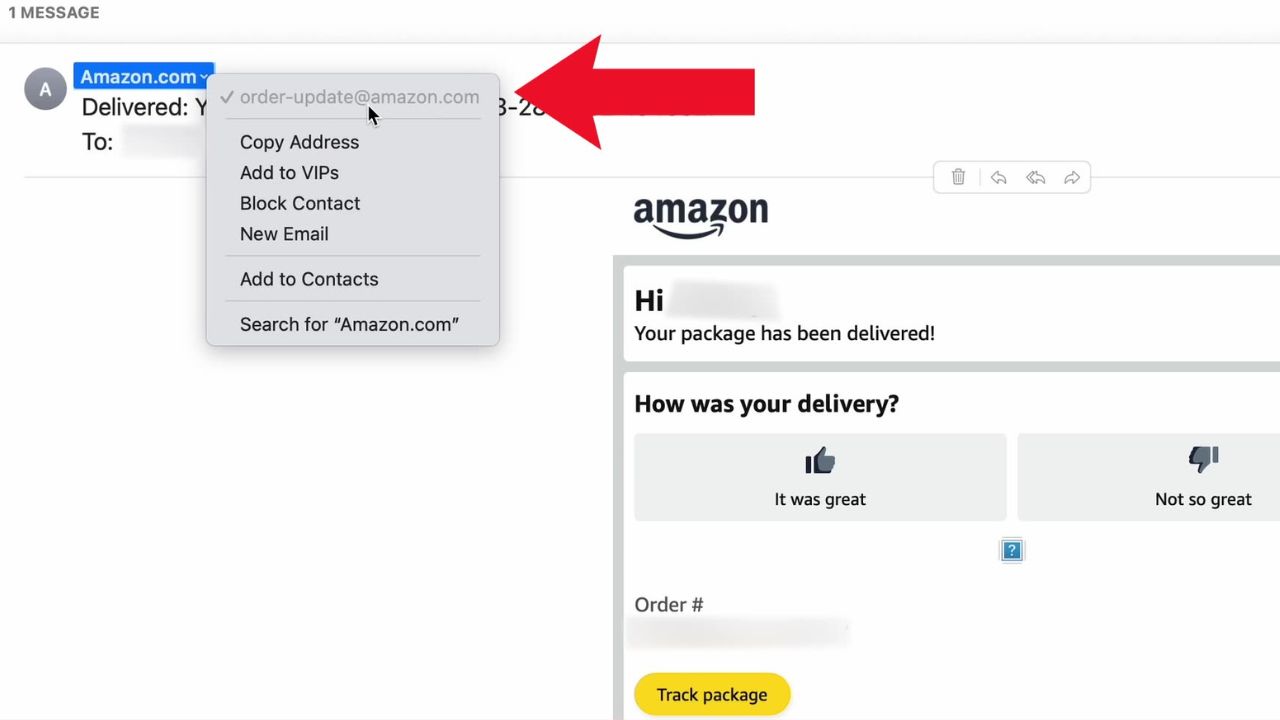Black Friday is around the corner, and by the time you finish your Thanksgiving leftovers, Christmas will already be knocking. That might be an exaggeration, but what’s not is the rise in impersonation scams as the holiday season approaches. With shopping in full swing, Amazon becomes an especially big target. Expect to see bad actors pretending to be trusted contacts, trying to access sensitive information like Social Security numbers, bank details, or Amazon account credentials.
To help you enjoy a scam-free shopping experience this holiday season, we spoke with Scott Knapp, VP of Worldwide Buyer Risk Prevention at Amazon, to learn how scammers impersonate the platform, what Amazon is doing to fight holiday scams, and how you can stay safe.
GET SECURITY ALERTS, EXPERT TIPS – SIGN UP FOR KURT’S NEWSLETTER – THE CYBERGUY REPORT HERE
The most common Amazon impersonation scams
Amazon is the world’s largest e-commerce platform, and it becomes even more relevant during the holiday season. With so many of us hunting for deals, scammers are well aware and ready to take advantage. They often use impersonation scams to trick shoppers into handing over card details or other sensitive information.
“During the 2023 holiday shopping season (Black Friday through Christmas Day), the most commonly reported impersonation scam by Amazon customers involved fake order or shipping confirmations claiming that payment was required in the U.S. There was nearly a 1.5x increase in reports of this scam from three weeks prior,” Knapp said.
Another common impersonation scam around this time involves fake purchase alerts for popular tech products. Knapp said that Amazon saw about a 13x spike in customer reports compared to three weeks earlier.
HERE’S WHAT RUTHLESS HACKERS STOLE FROM 110 MILLION AT&T CUSTOMERS
What is Amazon doing to keep customers safe?
It’s clear that many scammers are trying to target Amazon customers, so I wanted to understand what the company is doing to keep them safe. I asked Knapp a bunch of questions about how the e-tail giant is staying ahead of the latest online holiday scams, and you can read his responses below.
How is Amazon working to take down phishing websites and phone numbers used in impersonation schemes?
Our goal is to ensure that customers are protected when they shop on Amazon. That is why we are initiating the takedown of scammers with public-private partnerships to hold bad actors accountable. We have a team – including machine learning scientists and expert investigators – who protect our store and consumers from fraud and other forms of abuse.
In 2023 alone, we initiated takedowns of more than 40,000 phishing websites and 10,000 phone numbers being used as part of impersonation schemes. We can take down reported scam phone numbers the same day and phishing websites in just a couple of hours. We also partner with law enforcement across the globe to ensure scammers are held accountable, including having referred hundreds of bad actors to authorities.
Can you explain how Amazon’s email verification technology helps identify phishing attempts?
We’ve made it harder for bad actors to impersonate Amazon communications through implementing industry-leading tools, including the adoption of a secure email capability to make it easier for customers to identify authentic emails from Amazon and avoid phishing attempts. Customers using Gmail, Yahoo!, and other common email providers can be confident that when they receive an @amazon.com email with the smile logo in their inbox, that email is really from us.
Can you explain Amazon’s A-to-z Guarantee and how it protects holiday shoppers?
More than 60% of sales in Amazon’s store are from independent sellers—most of which are small and medium-sized businesses—providing a vast selection of amazing products, competitive prices, and convenience for consumers. When customers shop in the Amazon store, they can do so with peace of mind knowing that we stand behind the products sold in our store with the A-to-z Guarantee.
When a claim is filed, Amazon combines our advanced fraud and abuse detection systems with external, independent insurance specialists to analyze filings, take on the investigative work for our selling partners, present valid claims, and deny unsubstantiated, frivolous, or abusive claims. By doing this work on behalf of sellers, we save them from having to investigate these claims on their own. Innovating this process enables customers to shop confidently, which in turn drives selling partner success.
Amazon’s protection applies to physical products purchased in our store worldwide, and in the unlikely event that customers experience issues with timely delivery or the condition of their purchase, whether purchased from Amazon or one of our approximately two million selling partners, Amazon will make it right by refunding or replacing it. Whether during the holiday shopping season, or anytime throughout the year, customers can confidently shop Amazon’s vast selection of amazing products with the A-to-z Guarantee.
BEWARE OF ENCRYPTED PDFS AS THE LATEST TRICK TO DELIVER MALWARE TO YOU
How can Amazon customers stay safe?
1) Watch out for red flags: Some tell-tale signs of an impersonation scam include requests for account or payment information and creating a false sense of urgency. Amazon will never ask for your password, payment, or bank transfer through phone, email, or any external website. Scammers might reference a purchase (real or fake), a giveaway, a prize, or claim that “your account is locked,” urging you to click a link, make a payment, or buy a gift card.
2) Verify the email: For any questions related to an order, always check your order history on Amazon.com or via the “Amazon Shopping” app. Only legitimate purchases will appear in your order history. If you are ever unsure about the legitimacy of an email, go to Amazon’s website or app to access the Message Center and review authentic communications.
In addition, you should always check the sender’s email address by hovering over the “From” name and verify it’s a genuine Amazon email, which will come from “@amazon.com.”

3) Beware of phishing links: Avoid clicking on random links, especially in messages about shopping deals, order confirmations, or account issues. Scammers often use fake links to mimic legitimate retailers and steal your information.
The best way to safeguard yourself from malicious links is to have antivirus software installed on all your devices. This protection can also alert you to phishing emails and ransomware scams, keeping your personal information and digital assets safe.
My top pick is TotalAV, and you can get a limited-time deal for CyberGuy readers:
4) Don’t fall for “too good to be true” offers: Scammers often lure victims with irresistible deals, such as huge discounts on popular products or “exclusive” offers. If an offer seems too good to be true, it probably is. These offers might be tied to fake websites or phishing attempts designed to steal your personal and financial details. Always double-check the legitimacy of any deal before making a purchase. If you’re unsure, visit the official Amazon site or app to search for the product and compare prices.
5) Use a personal data removal service: Scammers can obtain your information from various online sources, including data brokers, people search sites, and public records. Using a data removal service can help reduce your digital footprint, making it harder for scammers to access your personal information. This proactive step can be crucial in preventing identity theft and minimizing the chances of falling victim to scams during the busy holiday season.
While no service promises to remove all your data from the internet, having a removal service is great if you want to constantly monitor and automate the process of removing your information from hundreds of sites continuously over a longer period of time.
A service like Incogni can help you remove all this personal information from the internet. It has a very clean interface and will scan 195 websites for your information and remove it and keep it removed.
Special for CyberGuy Readers (60% off): Incogni offers A 30-day money-back guarantee and then charges a special CyberGuy discount only through the links in this article of $6.49/month for one person (billed annually) or $13.19/month for your family (up to 4 people) on their annual plan and get a fully automated data removal service, including recurring removal from 190+ data brokers. I recommend the family plan because it works out to only $4.12 per person per month for year-round coverage. It’s an excellent service, and I highly recommend at least trying it out to see what it’s all about.
Get Incogni for your family (up to 4 people) here
6) Report suspicious activity: If you encounter an impersonation scam, your best course of action is to report it to Amazon. Knapp says, “The more consumers report scams to us, the better our tools get at identifying bad actors so that we can take action against them and protect consumers. If consumers suspect that they have encountered a scam, they can report suspicious communications to us at amazon.com/ReportAScam, so that we can protect their accounts and refer bad actors to law enforcement to help keep consumers safe.”
WHAT TO DO IF YOUR BANK ACCOUNT IS HACKED
Kurt’s key takeaway
Scammers will do their best to ruin your holiday season, but most of their tactics can be easily avoided with the right tools and a little common sense. Be cautious of unsolicited texts, emails, or phone calls offering deals, discounts, or asking for your personal information. If you’re shopping on Amazon, track everything through the Amazon app and reach out to their customer support for any concerns or questions.
What features or tools do you wish online retailers would implement to enhance customer security during peak shopping times? Let us know in the comments below.
FOR MORE OF MY TECH TIPS & SECURITY ALERTS, SUBSCRIBE TO MY FREE CYBERGUY REPORT NEWSLETTER HERE
Copyright 2024 CyberGuy.com. All rights reserved. CyberGuy.com articles and content may contain affiliate links that earn a commission when purchases are made.





